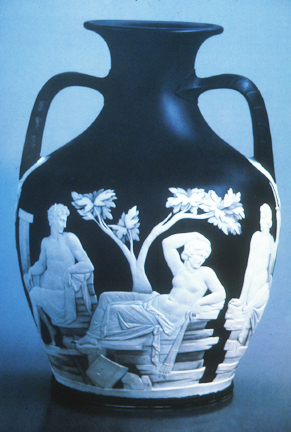The original Portland Vase is a Roman work of the 1st century AD of dark blue glass decorated with white figures, and is agreed to be the finest surviving Roman example of cameo glass. It was said to have been discovered in a sarcophagus outside Rome in the early 1580's, but there seems to be no contemporary documentation of its unearthing at this time. By the early seventeenth century it was owned by Cardinal Francesco Maria Borbone del Monte, who died in August 1626 and whose heir, Alessandro, sold it to Cardinal Antonio Barberini. The vase remained in the possession of the Barberini family, distinguished collectors of art in Rome who exhibited majestic paintings and sculptures in their palace, for 150 years. It is sometimes called the Barberini Vase. The vase was next acquired by a Scottish architect living in Italy, James Byres, who in the early 1780's sold it to Sir William Hamilton and Englishman with a rather interesting background. Around 1784 Sir William Hamilton was in England, and Margaret, the duchess of Portland, saw the vase he had brought with him from Naples. She was enthralled with it and sought it for her collection. Margaret was not able to enjoy her new vase for long, since she died on July 17, 1785, about a year after acquiring it. Margaret's son, the duke of Portland, purchased the ancient Roman vase and in 1810, after a family friend broke off the vase's base, lent it to the British Museum, where it presumably would be safe and could be enjoyed by a wide audience. In 1845, while in the British Museum (where it is now), the vase was smashed by a drunken museum goer, necessitating skillful and painstaking restoration.
In 1790, Josiah Wedgwood produced a limited edition of 'Portland Vases' done in a black jasperware he called 'basalt ware.'' The edition of porcelain vases is based directly on the original Portland vase in shape and surface design. The first edition of 30 vases was a huge success and Wedgwood would go on to reissue the design many times. Jasperware was so successful that it was even copied later by both Meissen and Sèvres. Wedgwood's neoclassic jasperware vases have proven remarkably impervious to changing tastes and may still be purchased today as the factory is still in operation.
Josiah Wedgwood was a man of many interests and was known to be an ardent supporter of liberal causes. He was a leader in the abolition of slavery movement as well as a supporter of both the American war of independence and the French revolution. He was also known as an inventor, and his invention of the pyrometer, a device for measuring high temperatures (invaluable for determining kiln heats for firings), earned him commendation as a fellow of the Royal Society. Among the many brilliant scientists with whom he was friends or collaborated was Erasmus Darwin, who encouraged him to invest in steam-powered engines. In 1782, Wedgwood's Etruria factory was the first to install such an engine. Wedgwood's daughter Susannah was the mother of Charles Darwin.

"Portland Vase," Porcelain 'basalt ware,'
Wedgwood, England 1790 CE, 10" height


